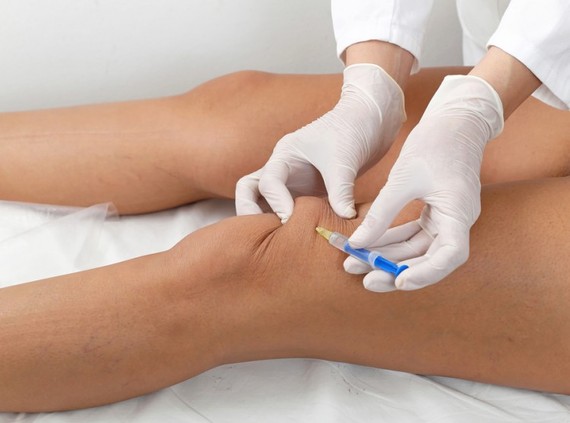Injections to the knee joint used to be scary, and almost always involved cortisone. No more. Here is what has changed.
Cortisone injections became popular because they shut down cell activity and inflammation. [1]
Unfortunately, this weakens the tissues in the process and thus inhibits healing. In our new "anabolic" era of medicine, we use another strategy: injections of growth factors from the platelets in your own blood, and stem cells from your own bone or fat. [2]
Unlike cortisone, these provide positive direct stimulation of healing tissues, and act as natural anti-inflammatories. The most recent data shows that these stimulants work as "medicinal" cells -- not only by providing the necessary proteins for healing, but also by choreographing a wide range of cellular stimulation. [3] They call new cells to the injury site, and activate cells already present.
By stimulating, rather than shutting down, cell activity healing can be optimized.
Knee injections can be nearly painless if several techniques are used. First, the patient must be relaxed. This way the muscles don't contract, forcing the kneecap against the femur and tightening the joint. Multiple deep, slow breaths usually do the trick -- but sometimes a distracting nurse, holding the patient's hand and telling a story is employed.
Next, after the skin is thoroughly cleaned, a local anesthetic (either as a topical ointment or injected with a micro dental needle) is used. This step is critical to having a painless injection. Waiting a few minutes and letting the anesthetic drug work is the key. Stretching the skin overwhelms nerve stretch receptors. Placing strong pressure on the opposite side of the knee with a finger desensitizes the remaining nerve fibers. Lastly, a fast and accurate placement of the needle diminishes any residual pain.
Lubricants are also injected into painful, injured or arthritic joints [4]. The most current versions are variations on hyaluronic acid, the natural oil inside the joint. When combined with growth factors or stem cells, the chemistry of the joint is altered -- producing pain relief with almost no downside. Unfortunately the data shows a wide range of responses [5]. About one third of the world are super responders: They have tremendous relief and can often tell me the very day the injection wears off -- three, six or 12 months later. Another third get mixed results, and the final third seem to experience no relief at all. I can't tell in advance who will respond until we try. For those that get relief, the results are often dramatic; the injections are nearly painless, and there is almost no downside except cost.
The future will be equally interesting. There may be genetic or epigenetic markers that will personalize medicine to such a degree that we know who is likely to respond, and to which factors. Current efforts seek to combine the growth factors with collagen or resorbable carriers that will delay or sequence the release into the joint, matching the natural timing of the cell cycle more closely. Lubricants, meanwhile, are evolving to incorporate other components of lubrication (not just hyaluronic acid). [6]
Unfortunately, other than glucosamine and chondroitin sulfate, no oral medications have shown significant efficacy in affecting joint biology -- though not for lack of trying.[7]
Fundamentally, joint injuries and arthritis are biological disorders which cause enormous biomechanical dysfunctions. As orthopedists, we were taught to first treat the disordered biomechanics, with implants and corrective surgery. But it is biologic stimulation and guidance which, combined with restoration of the cartilage, ligaments and bone, will ultimately provide the most effective and lasting cures.
References
1. Cardone, DENNIS A., and ALFRED F. Tallia. "Joint and soft tissue injection." Am Fam Physician 66, no. 2 (2002): 283-289.
2. Khoshbin, Amir, Timothy Leroux, David Wasserstein, Paul Marks, John Theodoropoulos, Darrell Ogilvie-Harris, Rajiv Gandhi, Kirat Takhar, Grant Lum, and Jaskarndip Chahal. "The efficacy of platelet-rich plasma in the treatment of symptomatic knee osteoarthritis: a systematic review with quantitative synthesis." Arthroscopy: The Journal of Arthroscopic & Related Surgery 29, no. 12 (2013): 2037-2048.
3. Wang-Saegusa, Ana, Ramón Cugat, Oscar Ares, Roberto Seijas, Xavier Cuscó, and Montserrat Garcia-Balletbó. "Infiltration of plasma rich in growth factors for osteoarthritis of the knee short-term effects on function and quality of life." Archives of orthopaedic and trauma surgery 131, no. 3 (2011): 311-317.
4. Evanich, J. David, Christopher J. Evanich, Mark B. Wright, and James A. Rydlewicz. "Efficacy of intraarticular hyaluronic acid injections in knee osteoarthritis." Clinical orthopaedics and related research 390 (2001): 173-181.
5. Leopold, Seth S., Brigham B. Redd, Winston J. Warme, Paul A. Wehrle, Patrick D. Pettis, and Susan Shott. "Corticosteroid compared with hyaluronic acid injections for the treatment of osteoarthritis of the knee." J Bone Joint Surg Am 85, no. 7 (2003): 1197-1203.
6. Fibel, Kenton H., Howard J. Hillstrom, and Brian C. Halpern. "State-of-the-Art management of knee osteoarthritis." World Journal of Clinical Cases: WJCC 3, no. 2 (2015): 89.
